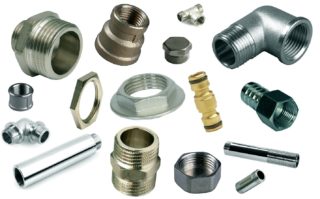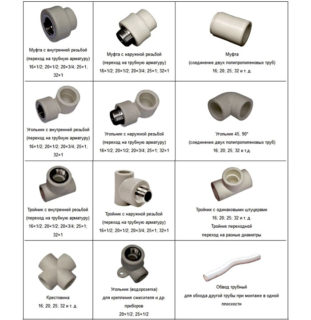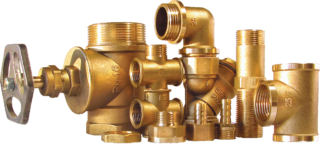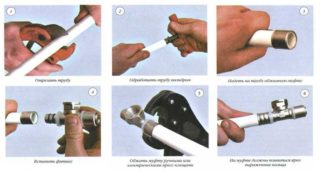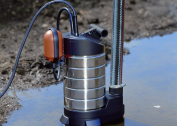Disparate parts of the water supply system are assembled into a single system using fittings. The selection of elements of sanitary fittings should be treated responsibly. The longevity and stability of the functioning of the entire water supply network depends on them.
Purpose of water fittings
According to the functional qualities, the shaped elements of the water supply system are divided into:
- reduction - are used if necessary, the connection of pipe segments of different sections;
- straight - are used when it is necessary to connect pipes of the same diameter.
One water main can be mounted from several pipe sections that are connected by different types of fittings.
Reinforcing elements for water supply should be economical, safe, reliably connect parts of the pipeline. If properly installed, leaks and condensation will not form.
The main types
You can subdivide shaped water elements in two large groups:
| Category Feature | Connecting the pipeline in a single line | Used to change direction or connect additional elements |
| Common Fittings | Adapters are used to joint elements of different sections. | Tees and crosses are mounted to combine several branches. |
| Fittings connect plastic and metal elements. | Bends at different angles are needed to change the direction of the highway, and bends - for a smooth bypass of vertical risers. | |
| Couplings are used to connect pipes of the same cross section in a straight section of the water supply. | Water sockets on the one hand are connected to the pipe, on the other, they have an internal thread, to which an eccentric of the mixer or a water supply hose is connected. | |
| Benefits | They make it possible to increase the length of straight trunk sections, connect various hoses to it, and integrate control or distribution systems. | They help when connecting to the main branch of several additional elements or lines for turning the trunk. |
The cross-section of the pipeline branches using the fitting parts of both groups can change or remain unchanged.
The design largely depends on the method of connection. Two types of fittings are popular: press fittings and compression parts. The first are a case with a crimp sleeve and a metal sleeve located inside. The second ones have a similar structure, but instead of a sleeve there is a fitting, and a split ring corresponding to the outer section of the pipe is used as a clamp. Both the first and second are equipped with a fixing nut in the place of connection of the pipe section. But there are other options - with internal or external threaded thread (metal only), installed by soldering or glue (plastic only).
Specifications and selection criteria
The main design characteristics that need to be considered when choosing a part:
- internal and external section;
- threaded diameter;
- operating pressure;
- temperature conditions (for hot and cold water branches, fittings may vary).
The dimensions of the parts are also very different. For example, for polypropylene pipelines, fittings with a cross section of 16–63 mm are produced for systems with a pressure of up to 16 bar, and 75–110 mm for networks where the head reaches 75–100 bar.
The most commonly used fitting elements for plastic water pipes with a section of 20, 25, 30 and 40 mm.You can find fittings with a cross section of up to 110 mm, but they are usually used when laying pipelines for industrial use. In a private house or city apartment, the best option would be to install a water supply system from pipes and fitting elements with a cross section of 20 mm.
Production material
Shaped elements for a water supply system are made of various metals and polymers. Metal fittings can be:
- brass;
- copper;
- steel;
- cast iron.
The first two types are less susceptible to corrosion than the rest.
Plastic options are made of polyethylene, low pressure polypropylene (HDPE) or polyvinyl chloride (PVC). Installation of the latter is carried out on non-pressure water supply systems. Polyethylene products are mounted on both pressureless systems and pressure pipelines, while propylene products are most often used for pressure systems.
The advantages of polymer parts in resistance to corrosion, budget cost and a wide range. They are lightweight, durable and easy to install. The cost of such products starts from 40 rubles. The average price is 100–300 rubles.
Metal fittings cost 2 times more than, for example, PVC fittings for plastic water pipes. The advantage of metal elements over polymer in increased strength. In domestic water supply, this factor is not so significant, therefore, plastic pipes are increasingly being installed. Shaped parts must be made of appropriate materials. It is not advisable to combine different types of pipes and fittings.
Mounting Features
Installation rules depend on the design of the element itself. For example, press fittings are often used to connect pipe segments from plastic. This type of connection elements is considered the most reliable. Installation of press fittings is carried out using an electro-pneumatic press clamp or special press tongs, which reduce the size of the coupling area at the pipe connection. With self-assembly, the tool line may not be at hand, so you can use a simpler version of press fittings with a crimped nut.
Installation is performed in the following sequence:
- With a knife, pipe sections are cleaned and dirty spots are removed.
- The nut for fixing and the cut ring is put on.
- It is applied to the inside of the ring plumbing grease or petroleum jelly. This allows the pipe to be connected without distortion.
- The cut ring advances to the edge and is twisted with a nut.
Installation of compression fittings takes place with a wrench. On such fittings for water supply, the inner crimp ring is tightened, so that the fitting is fixed to the pipeline. Minus of this reinforcement - constant pulling is required.
Compression fittings, unlike press fittings, are much easier to install. But due to the direct influence of the human factor on the connection, when the master can tighten or not tighten the nut, it is not recommended to hide the lines with their use in the walls. The location of the pipeline in an open space is more convenient in terms of maintenance and operation: the compression elements are removable, if necessary, they can easily be tightened to increase the tightness of the connection.
Another option for connecting the trunk is using special glue. It is suitable for parts that do not have the necessary elements for pairing. Bonding is also carried out in several stages:
- Before connecting the pipes with fittings, you need to process their edges. This can be done with a special knife that eliminates all bumps.
- Remove dirt and grease with acetone or solvent.
- Apply adhesive and connect pipes using fittings.In this case, it is necessary to maintain pressure for a minute.
The use of the pipeline is allowed after a few hours, so that there are no tears or leaks.
One-piece molded plastic fittings are mounted in the pipeline by soldering under heating. Welding systems are used to create heating and plumbing systems with different volumes of water supply. It is possible to do it yourself with a special soldering iron. Docking ends are heated to the required temperature. After connecting and cooling, the two elements will become a single integral unit. In the case of metal analogues, you usually have to call a welder.
There are a large number of different types of fittings used for installation and installation of water mains. It is important to choose the type that is suitable for the needs, taking into account the cross-section and material of the pipes.
